Fact: Jupiter is the best planet. What’s not to like? Big, beautifully stripey, four exciting moons, hurricane three times the size of the Earth, lots of fascinating hydrodynamics…I could go on. But Jupiter isn’t just awesome on its own. It was also the site of the first observed extraterrestrial impact event, and is routinely struck by asteroids and comets. Last week on Monday the 10th another piece of cosmic debris impacted the planet, producing a brief fireball spotted by amateur astronomers and providing an excellent opportunity to reflect on the history of impacts in Jupiter and the solar system at large.
Jupiter has 67 known satellites, but only 8 are considered regular, i.e. they have stable, prograde, roughly circular, roughly planar orbits. The rest of the satellites are irregular and are likely captures. Jupiter’s mass means that it scoops up nearly everything that passes near it. The area of gravitational influence around a body orbiting another, much larger body is called the Hill sphere. Within the Hill sphere a satellite can be considered to orbit the smaller object (the planet) rather than the central one (the Sun). The Earth has a Hill sphere radius of about 1.5 million km, or 1% of the distance between it and the Sun. Jupiter, on the other hand, has a Hill sphere radius of about 53 million km – 0.355 AU, or nearly 7% of the distance between it and the Sun. This radius is well away from the bulk of the main asteroid belt, but close enough to pick up strays – and anything foolish enough to come close to the giant planet.
In 1993 astronomers Carolyn and Eugene Shoemaker along with David Levy identified a new comet, christened Shoemaker-Levy 9 (SL9). After follow-up studies, they realized two strange things about it: it was actually a string of objects, and it was no longer orbiting the Sun but had been captured by Jupiter. By analyzing the orbit and the composition of the comet fragments, they concluded that the solid nucleus had passed so close to Jupiter back in 1992 that it had been torn apart. Even more exciting, projections of the orbit predicted that it should collide with Jupiter in 1994. The comet was doomed. Astronomers were thrilled.

Shoemaker-Levy 9's "string of pearls," the fragments of the disrupted comet. They ranged from a few hundred meters to 2 kilometers in size. (Image: NASA/ESA/H. Weaver and E. Smith)
The impact of Shoemaker-Levy 9’s famous “string of pearls” was captured by dozens of observatories as well as the Galileo spacecraft. As each fragment plummeted into the planet, it produced a fireball and an immense “bruise” – a dark blotch composed of vaporized comet and material plowed up from deeper layers of Jupiter – and told us a great deal about both the composition of the comet and of the Jovian atmosphere.
SL9 was a dramatic series of impacts, ultimately involving 21 fragments with diameters ranging from a few hundred meters to 2 km. The scars produced in Jupiter’s atmosphere lasted for months. But it’s far from the only impact involving Jupiter in recent memory. In 2009 amateur astronomer Anthony Wesley observed a new dark spot appearing on Jupiter, similar to SL9’s bruises. After following it to make sure the spot wasn’t just a polar storm, he alerted NASA and JPL astronomers, who trained their instruments on it and determined it was another impact scar. The impacter (not captured) is thought to have 200 – 500 meters in diameter, and created a spot about the size of the Pacific Ocean. In 2010 two more impacts were captured, this time spotted by the flash they made on impact (neither was big enough to leave a scar).
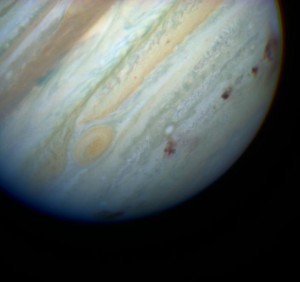
Impact scars from SL9 in the Jovian atmosphere. The dark bruises come from aerosol debris from the impactor mixed with material brought up from the deep atmosphere. These scars persisted for months. (Image: Hubble Space Telescope Comet Team and NASA)
And just recently on September 10th amateur astronomers captured a fireball as another anonymous piece of space debris crashed into the cloud tops. You can watch one of the astronomers’ video here. With the increasing prevalence of amateur video astronomy we’re recording more and more of these events, and it highlights the important role of Jupiter’s massive gravity in clearing the solar system of debris. To put it simply: Jupiter takes the hits so we don’t have to.
Impact events were common in the early solar system when the planets were busy sweeping up the leftovers of the presolar nebula. Many of the large-scale features in the solar system are thought to have been formed at least partially by impacts (as a planetary scientist once told me, “When in doubt, appeal to a giant impact.”) During a period of about 4.1 – 3.8 billion years ago, at the tail end of the solar system’s formation, a hail of debris rained down on the inner planets in an event known as the Late Heavy Bombardment. This battering produced the lunar maria, the Hellas Planitia on Mars, and the Caloris Basin on Mercury.
For the inner planets, such adolescent scrapes and bruises are largely a thing of the past. The idea of a massive impact event occurring on Earth had been largely dismissed as science fiction until 1981, when physicists Luis and Walter Alvarez connected the Cretaceous-Paleogene extinction with an impact event. In 1990 a massive, sunken, ringed structure in the Yucatan peninsula was recognized as the ancient crater from that impact, which occurred only 65 million years ago – a blink in solar system time, and an idea that made people distinctly nervous. The follow-on of SL9’s dramatic show on Jupiter in 1994 didn’t help; it’s probably no surprise that the two most famous “object hits Earth” movies – Armageddon and Deep Impact – were both made in 1998, just four years after the event.
But the odds of a large asteroid impact on Earth are staggeringly low, and with the advent of sky monitoring and the WISE infrared survey of asteroids, we think the bulk of the near-Earth objects capable of posing a threat (diameter > 1km) have been detected and catalogued. And at least part of our relative freedom from massive impacts is due to Jupiter. The planet is thought to be struck by 1.5 km size comets about every 100 – 500 years, and every one of those is a comet that didn’t hit us. So, Jupiter: best planet? Best planet.


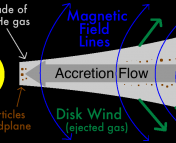
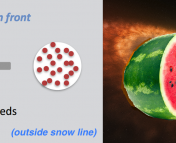
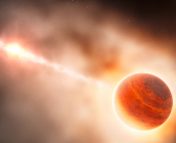
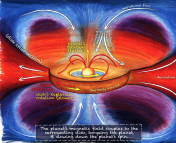
Trackbacks/Pingbacks